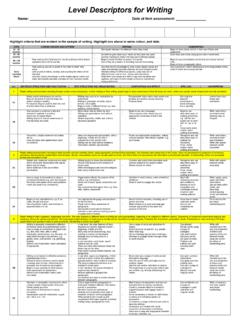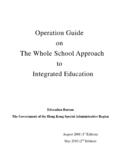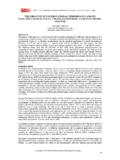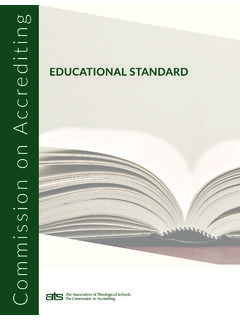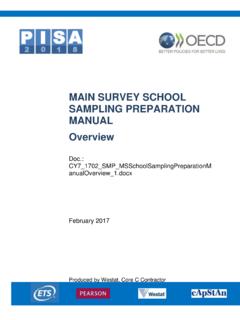Transcription of Setting targets for pupils with special educational …
1 Page 1 Setting targets for pupils with special educational needs HMI 751 February 2004 Page 2 Crown copyright 2004 Document reference number: HMI 751 To obtain an additional copy, contact: Ofsted Publications Centre Telephone: 07002 637833 Fax: 07002 693274 E-mail: Web site: This document may be reproduced in whole or in part for non-commercial educational purposes, provided that the information quoted is reproduced without adaptation, and the source and date of publication are stated.
2 Page 3 Contents Introduction _____ 4 The purpose of the report _____ 4 Main findings _____ 6 Recommendations _____ 6 Setting targets _____ 8 Individual pupil targets _____ 8 Statutory target- Setting in special schools _____ 9 Additional performance targets _____ 14 Curriculum development and teacher assessment _____ 15 Whole-school improvement _____ 17 Managing target- Setting _____ 20 Moderation of teacher assessment _____ 20 Monitoring and analysis of data_____ 21 Performance management _____ 22 Conclusion _____ 23 Page 4 Introduction There has been a statutory requirement on all schools since 1998 to set performance targets in relation to national expectations for raising However, special schools which educate pupils with moderate, severe and profound learning difficulties have usually set zero-rated targets because their pupils would not be able to achieve the levels expected of the majority of pupils at the end of each key stage.
3 In March 2001, guidance from the Department for Education and Skills (DfES)/Qualifications and Curriculum Authority (QCA) was issued to This included small steps criteria to support teacher assessment against National Curriculum levels. These have become known as P scales .3 From December 2001, maintained special schools were no longer permitted to set zero-rated targets , and are now required to use P levels or other appropriate measures (in addition to National Curriculum levels and General Certificate of Secondary Education (GCSE) grades) to set school performance targets . There remains a tension between this duty to set school performance targets and the fact that there is no nationally agreed instrument of assessment. Independent special schools do not have a statutory duty to set performance targets . The purpose of the report Her Majesty s Inspectors (HMI) conducted a series of school visits between December 2002 and May 2003.
4 The 68 schools included ten mainstream primary schools, eight mainstream secondary schools, and 42 maintained special schools (half of which were schools for pupils with severe learning difficulties (SLD) or profound and multiple learning difficulties (PMLD)). There were also eight independent special schools; four of which were for pupils with emotional, social or behavioural difficulties (EBSD) and four for pupils with complex physical, medical, communication and learning needs . Ofsted reported recently on assessment issues including target- Setting for pupils in mainstream secondary This present survey complements the earlier work by reporting on progress made mainly though not exclusively by special 1 Target Setting in Schools (Circular 11/98): Department for Education and Employment (DfEE). 2 Supporting the Target Setting Process: Guidance for effective target Setting for pupils with special educational needs (revised version March 2001) (DfES 0065/2001).
5 3 The P scales are a set of performance descriptors used for recording the attainment of pupils with special educational needs (SEN) working towards the first level of the National Curriculum. In the core subjects of English, mathematics and science, the levels extend from P1 (lowest) to P8. Levels P1 to P3 are further broken down into two sub-levels, for example P1(i) to P1(ii). At this level they are not subject specific and the indicators relate to general skills at very early stages of development. Some strands of National Curriculum levels 1 and 2 are additionally broken down into three levels (1C to 1A, and 2C to 2A). There are also P levels for all National Curriculum foundation subjects, and these extend from P1 to P8, again with sub-divisions at P1 to P3. Some schools have successfully supplemented these descriptors with the use of commercially available schemes that sub-divide P levels into even smaller steps.
6 Work has been done to allocate point scores to each P level, as in National Curriculum levels, and these can be used to measure progress and so contribute to value-added scores at both individual pupil and whole-school levels. 4 Good Assessment in Secondary Schools, (HMI 462), Ofsted, 2003. Page 5 schools in Setting performance targets for pupils with SEN. The report identifies both innovative approaches as well as the difficulties schools face, and aims to clarify the extent to which target- Setting for pupils with SEN is helping schools to improve. The term special educational needs includes pupils of all ability levels who may have needs in cognition and learning, communication and interaction, sensory or physical aspects, and/or behavioural, emotional and social development.
7 This report is essentially concerned with target- Setting for pupils whose levels of ability and attainment are well below those expected for pupils of a similar age. Their attainment is below National Curriculum level 2 by the end of Key Stage 2, and below National Curriculum level 3 by the end of Key Stage 3. They are also likely to experience learning difficulties and be identified as requiring additional support from the school (school action), or external support (school action plus), or have a statement of 5 special educational needs Code of Practice, DfES, 2001. Page 6 Main findings ! Target- Setting has the greatest impact when it focuses on precise curriculum objectives for individuals and when it forms part of a whole-school improvement process.
8 ! Eight out of ten of the maintained special schools visited set and published statutory performance targets . ! Almost all special schools use P levels to assess individual pupils and set their targets , although they face difficulties in Setting targets realistically for attainment five terms ahead in order to meet statutory requirements. Schools for pupils with PMLD experience particular difficulties in this respect. special schools need more support from LEAs if they are to set up effective information systems to track pupils progress and analyse data over time. ! Mainstream schools are not required to set performance targets for pupils who are unlikely to achieve national expectations. Many are in a position to do so because they may have developed expertise in tracking pupils progress and analysing school performance data, but they do not always do this for pupils with SEN. ! Although moderation of teacher assessment for the majority of pupils is satisfactory across most schools, it is underdeveloped in relation to the assessment of pupils with SEN.
9 special schools have increasing expertise in teacher assessment using P levels, and in some areas this is being shared effectively with mainstream schools and LEA officers. ! Many schools see the importance of Setting individual targets and recording progress in terms of personal and social development, but not many do so systematically. ! Most schools use target- Setting to inform performance management, though they do not always link teachers performance to evidence of improved pupil performance. ! The role of governors in overseeing target- Setting , including for pupils with SEN, is underdeveloped. ! Comparing the performance of special schools is difficult and currently of limited value given the diversity of SEN within individual schools, the small numbers of pupils in year groups, the often wide age-range of some classes, and the great variety of assessment approaches in use. However, there is value in comparing the progress of pupils of similar ability at the same age and starting point in different schools.
10 This would be more soundly based if there was greater general understanding of and agreement on criteria for assessment. Recommendations To improve the use of target- Setting for pupils with SEN: ! special schools should: Page 7 collate pupil assessment and achievement data over time at individual, cohort and whole-school levels develop their expertise in analysing assessment information to inform school improvement planning. ! mainstream schools should: incorporate assessment and recording arrangements for pupils with SEN into their whole-school arrangements for all pupils develop their expertise in Setting targets and monitoring the progress of lower-attaining pupils set performance targets for all levels of pupil ability and publish these to governors.

